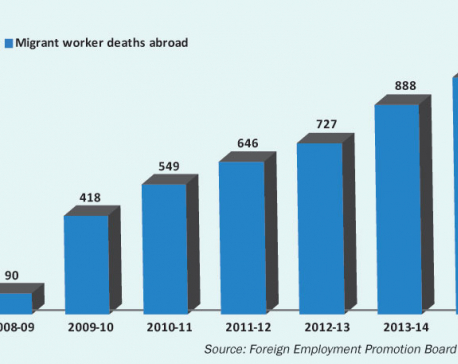
OR
25% of migrant workers' earning goes to repay loans: NRB report
Published On: September 27, 2016 05:29 AM NPT By: Sagar Ghimire | @sagarghi
KATHMANDU, Sept 27: Nearly 52.1 percent of Nepali migrant workers still rely on informal channel like local landlords and traders for loans to finance their foreign employment trip, requiring them to allocate a major chunk of their earnings for the repayment.
A report prepared by the Research Department of the Nepal Rastra Bank (NRB) shows that 4.4 percent of migrant workers borrow from cooperatives, while 3.5 percent get loans from their friends and relatives. Only 6.3 percent workers acquire loans from bank and financial institutions to go abroad. Similarly, 21.4 percent workers use their and their family's savings to finance their foreign employment trip, while 1.3 percent workers sell their fixed assets, the report shows.
Experts say that the reliance of migrant workers on informal channels for loans leaves them vulnerable to financial exploitation through exorbitant interest rates. “The families relying in informal channel for loans have to pay interest rate ranging from 12 to as high as 60 percent,” reads the report, highlighting the exorbitant interest rate and the huge amount of earnings that the migrant workers and their families have to pay to the lenders. "Around 95 percent of the workers have to pay 24 percent or higher interest rates," the report added.
Migrant workers have to allocate a huge portion of their income to repay the loans that they borrow from informal channels. "As the cost to go for employment is high and there is a compulsion to borrow money at exorbitant interest rates, migrant workers have to allocate a huge portion of their earnings in repayment of their loans," reads the report.
Migrant workers in rural areas are more likely to depend on informal channels to borrow money, according to the report. Nearly 59.2 percent of migrant workers in rural areas and 52.2 percent workers of urban areas seek financing from informal channel.
Lack of banking knowledge, low presence of BFIs in rural areas, complex borrowing process, and lack of collateral are some of the reasons that the report has attributed to migrant workers' reliance to informal channel for loans.
The study shows that 25.3 percent of the income of migrant workers in the last one year is spent on repayment of loans. "As migrant workers become indebted while they go for employment and the families also borrow to buy fixed assets, most of the remittances income is used for repayment of the loans," the report added.
Migrant worker families spent 23.9 percent of the remittance transfer on consumption like food and cloths. 9.7 percent on education of children and health, while 3.5 percent is spent on social works like marriage ceremony. The remittance receiving household spends 3 percent of remittance on fixed assets and 5.5 percent on 'other expenses'.
The finding of the central bank's report is based on the field survey of 320 remittance receiving households of 16 districts.
A Nepali migrant worker sends home Rs 44,333 per month in average, according to the report.
You May Like This

Mortality among migrant workers same as for other Nepalis: ILO report
KATHMANDU, Sept 20: The death rate among migrant workers is similar to that of the Nepali population for the same age... Read More...

After disappointing jobs abroad, migrant workers find orange farming at home more profitable
PARBAT, Aug 7: Nar Bahadur Paija of Baskharka, Parbat district, spent his five precious years in Malaysia and Qatar as a... Read More...

NRB may seek proof of earning for exchange
KATHMANDU, Nov 12: Nepal Rastra Bank (NRB) officials have said that they may ask people having 1,000 and 500 Indian rupee... Read More...




Just In
- MoHP cautions docs working in govt hospitals not to work in private ones
- Over 400,000 tourists visited Mustang by road last year
- 19 hydropower projects to be showcased at investment summit
- Global oil and gold prices surge as Israel retaliates against Iran
- Sajha Yatayat cancels CEO appointment process for lack of candidates
- Govt padlocks Nepal Scouts’ property illegally occupied by NC lawmaker Deepak Khadka
- FWEAN meets with President Paudel to solicit support for women entrepreneurship
- Koshi provincial assembly passes resolution motion calling for special session by majority votes







_20220508065243.jpg)






Leave A Comment